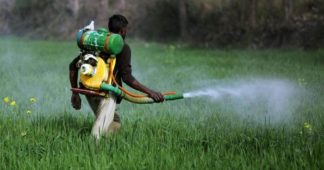When I started working for the Pesticides Program of the US Environmental Protection Agency in May 1979, I never imagined that pesticides were so pervasive and disruptive in both society and nature. But my college education in zoology and history quickly bridged the gap. As an “analyst,” I worked closely with toxicologists, biologists, ecologists and economists. I listened to their discussions and read their memos. I attended meetings between industry lobbyists and senior EPA officials and scientists. I realized outsiders – mostly lobbyists — were trying to influence, indeed, impose their ideas on what EPA scientists thought of the hazardous materials they regulated. It did not take me long to figure out I was in the midst of a scientific community under attack from within and without. The multi-billion dollars pesticide industry was determined to have its way, no matter who run Congress and the White House. Elihu Vedder’s Corrupt Legislation had triumphed. But before explaining the consequences of corruption, some historical background helps.
From Nature to petrochemicals
Pesticides are the guts of giant mechanized agriculture. They are the pillars of one-crop farming. They kill visible and invisible insects and other organisms around the seeds in the soil and around the growing crop. In fact, the genetically engineered seeds give rise to a pesticide-crop. In other words, the farmer uses pesticides and grows pesticides.
However, before chemical pesticides appeared in the growing of food, a new civilization emerged in Europe. That civilization was made up of mechanical view of nature, which were supported by a plethora of machines to do what farm animals and humans did in the growing of food. This emerging factory prepared the road to giant agriculture – and pesticides. This mechanical universe was a result of the ethical failure of our age. The eras of the Renaissance and Enlightenment, fifteenth to eighteenth centuries, and that of the Industrial Revolution of the nineteenth century absorbed the scientific and technological remnants of Greek civilization but ignored its ethical background. The Greeks thought of the Earth, the natural world, and, particularly, agriculture as sacred, an idea wholly alien to the Christians and other monotheists of Europe.
The Europeans kept the Roman legacy of slave-powered large farms. The result was industrialized farming. It started in late nineteenth century. Machines replaced animals in the cultivation of the land and the irrigation and harvesting of crops. The size of the farms expanded without limits. Stone and wooden fences between farms became obsolete. The new mechanized farm surpassed the slave-run plantation of medieval Europe. Almost nothing could stand on its way, least of all animals. In 2020, the Grace Communications Foundation rightly concluded that Big Ag has been addicted to petroleum. Farmers burn vast quantities of petroleum for running their large tractors and other machines. They burn even more petroleum in the “inputs” they use, huge quantities of synthetic fertilizers and pesticides, without which they are dead in the water.
Industrialized farmers plant crops like corn and soybeans alone in gigantic sections of land. Seed corn, for instance, is “dressed” in deadly neurotoxic insecticides known as neonicotinoids. This makes the growing corn plant a pesticide, deleterious to honeybees, other beneficial insects, and insects-eating birds. Corn, in most instances, has been genetically engineered to tolerate a variety of popular weed killers and insecticides. Farmers spray their fields sowed with genetically engineered seeds with toxic and cancer-causing weed killers like glyphosate (roundup). They know glyphosate will not kill their crop. It does not. Bu farm biocides like glyphosate are made up of cocktails of deleterious chemical pesticides. They are sprayed over gigantic land areas growing crops. This makes agricultural fields deadly to life. This is especially true for insects, birds, and other animals.
Just like wildlife, farmers pay a high price for their devotion to dope drugs-pesticides. Nemesis (retribution) appears in the form of cancer. It is their greatest threat. The great Greek epic poet Hesiod says Night gave birth to Nemesis (Theogony 223). Nemesis is divine and human retribution against those abusing the natural and moral order of societies and the Cosmos. Having too much power, wealth, pride, hubris, land, and fighting unjust wars suffices to bring severe punishment from the goddess of retribution, that is, Nemesis.
In our culture there are no Greek gods, but hubris is the king. We have this manufactured illusion we know better than our ancient ancestors. So, industrialized farmers and fossil fuel billionaires see nothing wrong in poisoning the Earth and the very food we eat. Of course, they would say the chemicals they use are vetted by the EPA, so they could not possibly be poisoning the food we eat. I wish that was true. But it is not. Corruption explains why. I wrote an entire book, Poison Spring, documenting that corruption.
Climate chaos
Fossil fuel executives add to the harm of pesticides and industrialized farming by warming the planet. These industrialists deny science. They commit a moral crime of cosmic proportions. They know they should not be doing that, yet they continue to undermine democracy, civilization, and the planet. They have been a perpetual political threat. All fossil fuel industry executives and their political subsidiaries in Congress, the White House, the Supreme Court and federal and state courts, universities, churches and state legislatures are guilty of hubris. They know they are dragging America and the world to catastrophe. In 2022, the UN Secretary General Antonio Guterres accused them of not telling the truth. I would go further. They are liars and thieves of the future. “Simply put,” Guterres said, “they are lying.” Nemesis is watching them. They are bound to suffer from human retribution and divine wrath.
Nemesis
Nemesis is not imaginary or invisible. For example, industrialized farmers hooked on pesticides / biocides die from cancer at twice the rate city folk do. The more bushels of sprayed corn and soybeans farmers produce, the more bushels of corn and wheat and soybeans and fruit they harvest, the faster they go to their graves. Nemesis is avenging their foolish and dangerous habits. That is all a secret between them and the professors at the land grant universities, who know about this tragedy but keep tight lips and say nothing. This is not surprising considering that these professors designed the mechanical and chemical and biological warfare instruments of large farmers. And despite their propaganda of a food cornucopia and a golden age of farming associated with their invention of giant agriculture, industrialized agriculture in the United States has been an unmitigated disaster. The food they produce, for example, has more toxins than the food raised by small family farmers. The troubles of the farmers radiate beyond their farms. People who are not farmers but who live near farmers suffer from the diseases afflicting farmers, particularly deadly deformities for their children and cancer for themselves.
DDT – a chemical and political weapon
Farmers should have known better than becoming addicted to deleterious sprays. Morton Biskind, a physician from Westport, Connecticut, warned American farmers and scientists decades before the EPA came into being. He puzzled over the nasty behavior of the lay and scientific establishment when confronted with a disturbing rise of agrochemical disease among people and domesticated animals. At the peak of the cold war, in November 1953, in the American Journal of Digestive Diseases, he startled the scientific and policy elites with his facts of common diseases in animals and men. “Since the last war [of 1939-1945],” he said, “there have been a number of curious changes in the incidence of certain ailments and the development of new syndromes never before observed. A most significant feature of this situation is that both man and all his domestic animals have simultaneously been affected.”
Biskind was astonished that, with a few exceptions like that of hoof and mouth disease, the comprehensive 1942 edition of the US Department of Agriculture Handbook, Keeping Livestock Healthy, ignored the diseases ravaging America’s domesticated animals. This “coincidence” alone, he says, should have alerted scientists that something new was afoot, something terrible was affecting society and its animals. He named DDT the new factor wrecking human and animal health. The industry released DDT in 1945. By then scientists had studied DDT quite extensively. There was little doubt, he says, DDT played a pernicious role in the maladies affecting domesticated animals and people. “DDT,” he said, “was dangerous for all animal life from insects to mammals.” Despite the evidence on the dangers of DDT, Biskind says, people of knowledge and power turned a blind eye and refused to see DDT for what it really was. This indifference outraged Biskind. “Virtually the entire apparatus of communication, lay and scientific alike,” he said, “has been devoted to denying, concealing, suppressing, distorting and attempts to convert into its opposite, the overwhelming evidence. Libel, slander, and economic boycott have not been overlooked in this campaign. And a new principle of toxicology has… become firmly entrenched in the literature: no matter how lethal a poison may be for all other forms of animal life, if it doesn’t kill human beings instantly, it is safe. When nevertheless it unmistakably does kill a human, this was the victim’s own fault – either he was “allergic” to it… or he didn’t use it properly.”
This “new principle of toxicology” has become the norm. In its first years, early 1970s, the EPA realized it had to slay the chemical dragon minting money for the chemical industry, farmers, and countless non-farmers using pesticides. In 1972, the US Environmental Protection Agency banned DDT, dichloro-diphenyl-trichloroethane, king among sprays. It was DDT that was the granddaddy of the farmers’ agrarian wars. It came into being in 1939 when Paul Herman Mueller, a chemist working for the Swiss company, J. R. Geigy, discovered DDT’s killing power against insects. The military did not use nerve gases during World War II, but it used DDT to control a typhus epidemic in Italy in 1943 and 1944. Soon thereafter, DDT became the golden bullet in the war against nature.
Industrialized farmers and malaria workers made DDT a global spray with nearly miraculous effects. DDT was praised to heavens. In 1948 Mueller received the Nobel Prize in Physiology and Medicine for his research on DDT. But, in fact, it was not Mueller who received the honors of the Nobel committee. The Nobel Prize went to DDT. Yet the Nobel committee learnt nothing from this embarrassing episode. In 1970 it awarded its prestigious peace prize to an American, Norman Borlaug, an agronomist of the Rockefeller Foundation who sparked Mexico’s destructive conversion to the agribusiness farming of the United States. When Borlaug delivered his Nobel lecture (The Green Revolution, Peace and Humanity) on December 11, 1970 in Oslo, Norway, he was right to defend food as a moral right. He saw himself as one of millions of farmers, most of whom were small and humble. Yet he also defended agribusiness to the hilt, saying that without the “green revolution,” or the industrialization of Third World peasant farming, and continuous and increasing food production, there would be famine and hunger. Borlaug advocated the replacement of the peasants’ “stagnant traditional agriculture” with farming fueled by the Mexican dwarf wheat, the “powerful catalyst” of the green revolution. He praised the rapid “transplantation” of the high-yielding varieties of wheat, along with chemical fertilizers, which powered the forward thrust of industrializing the Third World countryside. His big dream was emptying Third World villages of bullocks and filling them up with tractors and threshing machines. A few months later, on November 8, 1971, he delivered the 1971 McDougall Memorial Lecture (Mankind and Civilization at Another Crossroad) at the UN Food and Agriculture Organization (FAO) in Rome. At this time, Borlaug addressed like-minded agronomists, technicians from all over the world who also dreamed of seeing the globalization of the , cornfield, Africa and Asia and Latin America full of pesticides, fertilizers, tractors and threshing machines. He sided with the Cold War policies of the United States, seeing agriculture but a mere tool in the broader goal of defeating communism.
The United States was then, in 1971, fighting the un-winnable but brutal war in rural Vietnam against the communist government of North Vietnam, which was fighting the joint armies of America and South Vietnam. The strategy of the United States was to avoid dominoes in southeastern Asia: If North Vietnam won, Cambodia, Thailand and Laos would become communist. That, the United States said, was the reason it was fighting communist North Vietnam. This was also the strategy of Norman Borlaug in Mexico. The Rockefeller Foundation sent him to Mexico so that the hungry peasants would not launch a revolution on America’s doorsteps. His “green revolution” was counterrevolutionary: It won ground by shredding peasant culture, plowing through the peasants’ land, fields of knowledge, seeds, festivals, gods, and traditions. In fact, in time, Borlaug’s American farming in the tropics emptied the countryside of bullocks, filling the villages with petroleum-burning tractors and threshing machines.
Borlaug expanded the polite speech of his Nobel Lecture, his litany of what made his wheat improvement program possible, offering a hymn to DDT, which, at that time the US Environmental Protection Agency threatened with extinction. He praised the “green revolution” (agribusiness), a gift of the Judeo-Christian civilization. He then denounced the enemies of industrialized agriculture, the “hysterical environmentalists – who are provoking fear by predicting doom for the world through chemical poisoning.” Borlaug had in mind the environmentalists of the United States whom he described as the “new aristocratic environmentalists.” These city folk, he said, employed “impulsive emotional myopic tactics” against agriculture and pesticides in particular. Borlaug lashed at the audacity of non-experts criticizing agricultural chemicals. He attacked Rachel Carson. In her 1962 book, Silent Spring, she accused farmers of causing ecocide. Borlaug was angry with Carson. He said badmouthing pesticides was a “vicious, hysterical propaganda… being promoted today [in 1971] by fear provoking, irresponsible environmentalists.” He traced the origins of the anger of the environmentalists to Rachel Carson, slandering her book as “half-science-half-fiction novel,” “a diabolic, vitriolic bitter one-sided attack on the use of pesticides, especially insecticides and weed killers.
His wrath was sweeping. He used the vocabulary of fundamentalist Christians, quoting the Bible, using terms like cult, conversion, and crusade. He attacked the “fickleness of nature” and the idea of the “balance of nature,” replacing it with his own social Darwinism mantra of “evolve or perish.” He insulted ecologists, environmentalists, organic gardeners, organic farmers, calling them irresponsible doomsayers, privileged folk who preached fads, being followers of cults. Borlaug, finally, said that without the “improved technology and higher yields” of agribusiness much more land would have to come under the plow. He blamed the environmentalists for shortsightedness, being responsible for the hesitation of the “privileged world” in converting the “forgotten world” to its agricultural cornucopia. Borlaug was defending DDT.
DDT wars
DDT played a strategic role. It was a silver bullet, a symbol of Western science and technology, a proven weapon of how to subdue nature, an elixir of cleanliness and even health. At least that’s how Americans looked at DDT in its early days. “Time Magazine” published a DDT advertisement on June 30, 1947, which captured the madness of American corporations. Pennsylvania Salt Manufacturing Company sponsored the DDT advertisement. “The great expectations held for DDT have been realized,” said the advertisement. “During 1946, exhaustive scientific tests have shown that, when properly used, DDT kills a host of destructive pests, and is a benefactor of all humanity…Today, everyone can enjoy added comfort, health and safety through the insect-killing powers of …DDT products…[DDT] helps to make healthier, more comfortable homes…protects your family from dangerous pests. Use…DDT Powders and sprays…then watch the bugs ‘bite the dust.’”
DDT did much more than kill insects. It doomed birds by making it impossible for the fertilized eggs to give birth to live chicks. Their brittle shell cracked under the weight of the adult bird during hatching. In a July 1975 report defending its 1972 decision against DDT, EPA connected this “reproductive impairment” with eggs “with shells which are thinner than the historical norms and results in such deleterious phenomena as cracking, egg eating by the parents, and nest abandonment.” DDT was particularly deleterious to predatory birds, bringing peregrine falcons, osprey, brown pelicans, bald eagles and condors to the brink of extinction. In addition, DDT killed insects and small animals, which ate DDT-poisoned fish and wildlife. The legacy of DDT and DDT-like chemicals is a long one because of their chemical properties: DDT belongs to the organochlorines, a huge group of chlorine-based poisons that last for decades in nature while accumulating in the fat of the animals eating them. However, it was the human effects of DDT that convinced EPA to ban it. Before it came into being, another federal agency, the giant Health, Education and Welfare Department, published a study in 1969 documenting, among other effects, the much larger concentration of DDE, the cancer-causing sibling of DDT, in the tissues and blood of black Americans.

Fat tissue levels of DDT in parts per million (ppm) by age and race, United States, 1968. Report of the Secretary’s Commission on Pesticides and Their Relationship to Environmental Health (Washington, DC: US Department of Health, Education and Welfare, December 1969).
EPA scientists became aware of this important report, but they ignored it. Under no circumstances would senior officials of EPA touched questions of race, especially when they knew that farm poisons like DDT harmed blacks and other minorities more severely than whites. Instead, in 1972, EPA considered DDT “a potential human carcinogen.” By that time, DDT had contaminated the country’s food, especially meat and milk.
Forever DDT?
I already said that DDT is a synthetic chemical invented in 1874. Several decades later, DDT merchants peddled it as a drug against malaria mosquitoes. The timing was perfect. World War II boosted malaria. The US Army doused troops with DDT. Farmers in America and other countries made it magical. They claimed they could not farm without it. They used it in huge amounts to wipe out pesty insects.

German farmers spraying DDT, 15 August 1953. German Federal Archive. Bundesarchiv, Bild 183-20820-0001 / CC-BY-SA 3.0 Photo: Krueger. Wikipedia Commons.
Such illiterate practices killed millions of birds by outright poisoning. DDT also made the shells of bird eggs so thin that they broke easily, thus making the reproduction of the birds impossible. But the farmers did not care. They had a free hand with DDT, though they had not foreseen the coming into being of the EPA. When EPA opened shop in Washington, DC, in December 1970, DDT was not in its immediate radar. Yet the Agency learned fast and, in less than two years, abolished DDT.
Banning DDT almost wrecked EPA. The merchants of DDT, the chemical industry, and farmers went hysterical with the loss of DDT. Chemical industry agents cried communism and the end of the world. Pesticide manufacturers threw the same lies and propaganda against EPA that they had rehearsed against Rachel Carson in the 1960s. They said America’s farmers would go out of business and we would all starve – that’s how high their gold-creating DDT was on their agenda. They had even convinced Supermarkets to fog their food with DDT. After DDT dropped from its pedestal, Congressional hearings, new legislation, reorganizations at the Agency, and industry pressure pushed EPA to the road of decline. A torrent of abuse and lies from farmers, industry, and politicians put a brake to moving forward in environmental protection. Political appointees forced EPA to adopt and adapt to corruption. It started playing the games of the industry, telling Americans to be cautious with pollution but regulating the industry way. But the industry way would not touch DDT. It had been made almost immortal. It lasts for decades in the environment. It transforms itself into other chemicals. Some of it is carcinogenic, like the isomer DDE. Some not. I remember conversations I had about DDT with my EPA colleagues, which still astonish me. When EPA made DDT illegal, in 1972, pesticide merchants used DDT in the making of new compounds. They dubbed the DDT parts of these new chemicals “inert” in order to mislead the government and the user, telling them those inert chemicals were harmless. Indeed, all pesticides include toxic and untested ingredients branded inert.
The politics of dumping DDT
Industrialized farmers, agribusiness, and landscapers in the United States used so much DDT that wastes from DDT production contaminated landfills and waters. The dumping of DDT was especially egregious and dangerous in Southern California. The dumping of DDT started in the 1930s, four decades before the creation of the US Environmental Protection Agency. But the case of illegalities with the disposal of this product, so much adopted by farmers, would not be an easy one to any state and national authority. Certainly the US Department of Agriculture, which “regulated” pesticides before EPA, loved pesticides. USDA embraced the DDT magic bullet.
Oleum / SOO sludge
So, despite the dumping of DDT even after 1970, EPA stood on the sidelines. However, it collected information — in thousands of pages –and waited for the political moment to talk. That opportunity came with President Joe Biden and the discovery of DDT barrels near Santa Catalina Island in 2021 by Professor David Valentine of the University of California, Santa Barbara. EPA spoke about DDT dumping in Southern California on April 20, 2021. An official memorandum from EPA’s Region IX in San Francisco explained how the DDT company Montrose got rid of its DDT wastes. Keith Olinger from Enforcement wrote the memorandum and sent it to Enrique Manzanilla of the Superfund. The EPA memorandum spilled the beans about Montrose, the largest DDT producer of DDT in the United States. The DDT factory of Montrose was in Los Angeles. Starting in 1948, Montrose hired California Salvage Company to do the dumping. According to the EPA memo, the Salvage Company did the following: “[It would send] a tanker truck to the Torrance facility, which would pump about 3,000 gallons of spent filtrate acid (aka, oleum, or “SOO”) sludge per trip from the facility’s waste storage tank into the tanker truck. This acid waste contained some DDT. California Salvage would then drive the trucks to the [Los Angeles] harbor and unload the waste onto a barge. The barges would be towed to an ‘approved’ location offshore and dispose of the acid waste directly into the ocean waters (though… rumors [had it] that California Salvage would sometimes dump the waste closer to shore). This process continued until the early 1960’s, at which point depositions [from former employees] indicate that Montrose built an acid recovery plant at the Torrance facility, and the company appears to have stopped using a contractor to arrange for the ocean dumping of Montrose’s waste acid from its DDT Plant.”

One of the thousands of DDT barrels dumped in the Los Angeles harbor, 1947-1982. Courtesy Professor David Valentine, UC Santa Barbara.
The Montrose company also discharged its untreated DDT waste directly into the sewers of the Los Angeles County. Eventually the sanitation authority of the County ordered the Montrose company to cease dumping into its sewers. EPA, meanwhile, was taking notes of these criminal activities but was saying very little. It was preoccupied with the ocean dumping of DDT. Its staff interviewed Steve Simanonok about the DDT dumping in the waters of California coast. In the 1980s, Simanonok worked as an EPA inspector. He confirmed the illegal activities of the corpore owners of DDT. He also revealed the immoral policies of the local California authorities that approved the DDT dumping. His testimony is included in the EPA memo on Montrose dumping of DDT. “The DDT waste acid,” he said, “was transported from the Montrose DDT plant by liquid waste haulers in bulk tanker trucks, loaded aboard California Salvage barges in bulk holding tanks, and discharged at sea as liquid waste as the barge circled the disposal site… A handful of LA City and LA County agencies created an early system of tracking the transport and disposal of industrial wastes in the 1940s and 1950s… multiple agencies coordinated this effort by requiring waste haulers to file monthly reports with these agencies… [reports] listed the generator of the waste, the type of waste, and the quantity of waste… California Salvage disposal of Montrose DDT waste acid at the permitted deep-water ocean disposal site, Site # 1, in the Santa Cruz basin off the Southern California coast… this site was established by the US Navy after WWII to dispose of military munitions. In fact, the founders of California Salvage were ex-Navy personnel who were aware of the disposal site and sought permits to expand the site for Southern California industrial waste, radioactive waste, laboratory waste, and medical waste.”
Metaphysics of the DDT pollution and crime
It’s hard to comprehend the vast implications of this crime of DDT dumping. EPA’s conclusion bypasses the intellectual, political, and scientific foundations of this immorality and crime. EPA said Montrose hired California Salvage to get rid of its DDT “acid waste.” California Salvage filled its tanker trucks with the DDT waste and transported it from the Torrance plant to the Los Angeles port where the stuff was transferred into barges and “disposed of in bulk directly into ocean waters.” In a comprehensive and insightful 2020 article, Rosanna Xia, staff writer for the Los Angeles Times, says she is certain that the dumping of DDT was a grave and lasting harm against environmental and public health. Moreover, such violent action was the “most infamous destruction [of ocean wildlife and nature] off the coast of Los Angeles.” The health and lives of the people and the ocean, she says, are “inseparable.” In 2022, Rosanna Xia continued he outstanding reporting on the DDT dumping in the waters of Los Angeles. She revealed that “other chemicals — as well as millions of tons of oil drilling waste — had also been dumped decades ago in more than a dozen areas off the Southern California coast.” Xia is rightly angry about “DDT’s toxic — and insidious — legacy in California. As many as half a million barrels of DDT waste have not been accounted for in the deep ocean.”
True. The retribution of Nemesis has been massive. DDT decimated wildlife and ecosystems. I am angry, too. All Californians should be very angry. Imagine dumping DDT and other hazardous wastes not merely near Catalina Island and the waters of the Los Angeles harbor but at 13 additional sites off the coast of Southern California. The stuff dumped included military explosives, radioactive waste, refinery, and petroleum waste – something like 3 million metric tons of petroleum waste alone. Are we to assume that Californian authorities were so incompetent or science illiterate that, honestly, they believed that the massive amounts of dangerous DDT stuff dumped in the waters of Southern California would be “inert”? Of course, not. Evidence of harm had been all over the natural world and in their cancer clinics. However, industrialized societies have never shined in either justice and democracy or ethical behavior.
“Deep ocean disposal of industrial, military, nuclear, and other hazardous waste was a pervasive global practice in the 20th century, the full magnitude of which remains unknown,” wrote David Valentine and colleagues in a scientific paper in the journal Environmental Science and Technology, 2019. “In the United States, records indicate that 50−97 million tons of industrial waste were dumped at sea, representing an unknown fraction of the total quantity.” These disposal practices mirrored corruption, corporate authoritarianism, bribes and deep immersion in the lies and propaganda of the industry. Otherwise, this crime will remain in the clouds of doubt. It’s the same political corruption embraced by the executives of fossil fuel companies and the G.O.P. who deny climate change.
Wildlife and humans in a sea of poisons and toxic wastes
This poison brew in the coastal waters of California is harming and killing fish and wildlife. The magnificent condors have been threatened with death and extinction. The condor, Gymnogyps californianus, is prehistoric. It dates from the Pleistocene, a geological epoch of very large mammals like mammoths and saber-toothed cats. The Pleistocene lasted from 2.6 million to 11,700 years ago. The condor thrived in the Pleistocene but barely survives our era. This anthropocentric period pretends guidance from science but, in fact, it serves corporate profit above all. The result? There were 22 California condors alive in the world in 1982. Forty years later, in 2022, there were 537 California condors alive primarily because government and environmentalists joined hands to save the condors from extinction. However, this marvelous and paradigmatic last-ditch effort is threatened by the ceaseless pollution of the Southern coast of California. Condors, and other birds of prey, eat fish-eating sea lions and dolphins. But sea lions and dolphins are afflicted by 40 poisons, especially DDT and DDT-like chemicals in the sea. No wonder birds of prey like condors carry seven times more DDT in their flesh and blood than other ocean coastal animals. Sea lions are overwhelmed by an epidemic of DDT-caused cancers. Some speculate that as many as 25,000 barrels of DDT waste litter the Southern California coast. According to Professor David Valentine who uncovered the DDT tragedy, “a ticking time bomb lurks 3,000 feet below the surface [of the sea].”
Condors eating carrion like sea lions or fish contaminated by DDT cannot reproduce. Their eggs have thin shells, which break easily, exactly like the eggs of birds in the early introduction of DDT in the environment. DDT is the “principal” cause of the thinning of the condor eggs. Condors and wildlife are not the sole targets of DDT. People swim in the polluted waters of Southern California. They also eat the fish from those DDT-drenched waters. Women eating fish-contaminated with DDT during pregnancy suffer or die from breast cancer. Their daughters are harmed by cancer and their granddaughters are at risk from obesity, or difficulties in becoming pregnant.
Cleaning the ocean
We should be grateful to Professor Valentine for discovering this horrific truth, harm, and crime 3,000 feet under the waters of Southern California. Funding more studies is necessary, but that is not the end of the story. The governor of California Gavin Newsom must see that such crimes cease, and the criminals brought to justice. He should seek assistance from the Biden administration to clean up the DDT waste and other toxic wastes in the ocean floor of Southern California. DDT barrels are probably 70 years old. Left in the waters, they will either disintegrate or fall apart from corrosion. They must be removed from the ocean floor before they release more poisons into the marine environment. The Pentagon should clean up its own explosive wastes as well.
Our scientists should follow the paradigm of Valentine. Fight for the public good. Use their knowledge and technologies to uncover and disclose the ecological and health harms of industrialized agriculture and other industrial activities. This behavior will help society fight an even larger danger from climate chaos, which already is harming humans, civilization, and the planet. The DDT tragedy is revealing the immense price we and our endangered natural world pay when science is misused, the industry reigns supreme, and crimes are covered up.
The DDT “contamination” of the ocean lapping the Southern California coast is much more than an example of pollution or a fancy and expensive Superfund site EPA has probably no intention or funds for cleaning up. It’s a gigantic crime involving the chemical industry and several governments, federal and Californian jurisdictions. The criminals ignored science and perpetuated this epic crime against human and environmental health, especially harming the sea.
Pesticides cause ecocide and disease
The US Environmental Protection Agency in its baby years dared to set the record straight about pesticides. Two reports dated 1972 and 1974 highlight the science on pesticides. The 1972 report, Pesticides in the Aquatic Environment, estimated that Americans, both farmers and urban people, used 634 million pounds of pesticide active ingredients (fungicides, herbicides, and insecticides) in 1962. By the end of the decade of the 1960s, in 1969, pesticides sprayed in American farms and cities reached 938 million pounds of active ingredients. EPA warned in 1972 that the impacts of pesticides “may have had an indirect insidious influence on the health and welfare of the population.” The concern was also strong on the toxic effect of pesticides on the very beginnings of life and mature organism: “On a cellular level,” said the 1972 report of EPA “pesticides can inhibit cell division, photosynthesis, and growth; [they] alter membrane permeability; change metabolic pathways; and inhibit the action of enzymes, including those functional in metabolizing steroid hormones (i.e., estrogen and testosterone), and the enzyme which is functional in the deposition of calcium carbonate in eggshells.”
The 1972 report continued:
“[Pesticides may also cause] changes [in the blood], systemic lesions in the brain, spinal cord, liver, kidneys, and stomach, and subsequent susceptibility to bacterial and fungal infections.” Two years later, in 1974, EPA published another revealing study, the Herbicide Report. The main conclusion of this study is that herbicides nearly remake the plants they touch by changing their physiology. The sprayed crops then are less capable of resisting pathogens and insects. Farmers using herbicides also disrupt crop rotation, “resulting in increase in pest weeds, insects, and pathogens that may require additional pesticides for control.” Moreover, herbicides may change the nutrition of crops. Second, weed killers may cause “serious insect-pest outbreaks” because they alter the chemistry of the plants, making them “more attractive and nutritious to insects.” Third, herbicides may, indirectly, stimulate the “reproduction” of insects.
Writing before the birth of EPA, John Ciardi, an American poet, explained the price of polluting the sea (Long Water Going, Saturday Review, March 18, 1967). His voice is that of Nemesis: “What can any man, or all mankind, do with a dirty sea? By the time we have finished poisoning every first thing, and thereby ourselves, all the games will be over, will it be any solace then to know that in time the waters will purify themselves again? The waters can only lose for a little while. But we can lose forever, damned by our own flow of refuse.”
We remind our readers that publication of articles on our site does not mean that we agree with what is written. Our policy is to publish anything which we consider of interest, so as to assist our readers in forming their opinions. Sometimes we even publish articles with which we totally disagree, since we believe it is important for our readers to be informed on as wide a spectrum of views as possible.











